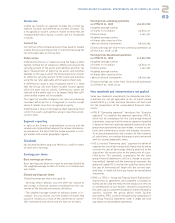Ubisoft 2007 Annual Report Download - page 65
Download and view the complete annual report
Please find page 65 of the 2007 Ubisoft annual report below. You can navigate through the pages in the report by either clicking on the pages listed below, or by using the keyword search tool below to find specific information within the annual report.
CONSOLIDATED FINANCIAL STATEMENTS AS OF MARCH 31, 2008
61
2
and estimated selling costs, which include marketing and
distribution costs.
No borrowing costs are included in the cost of inventory.
A provision for impairment is recognized when the likely
net realizable value falls below the carrying amount.
Reversals of inventory impairment are recognized as a
reduction of the amount of inventory expensed during the
fiscal year in which the reversal occurs.
Trade receivables
Trade receivables are defined by IAS 39 as financial instru-
ments, and are classified under “Loans and receivables”.
Trade and other receivables are measured at their fair
value upon initial recognition. Since receivables are due in
under a year, they are not discounted. Where applicable, a
provision for impairment is recorded based on the like-
lihood of collection at the balance sheet date.
Financial assets and liabilities
Financial assets and liabilities consist of assets available for
sale, loans and receivables, cash and cash equivalents,
derivatives and borrowings.
The Group uses the following financial assets and liabi-
lities.
These financial assets and liabilities are classified in cur-
rent or non current items in balance sheet following the
IFRS 5 rules.
Loans and receivables
They include deposits and sureties, as well as grants to be
received from the Canadian government.
Derivatives
In order to limit the Group's foreign exchange risk, Ubisoft
Entertainment SA uses forwards and foreign exchange
options to hedge the risk of exchange rate fluctuations. As
these transactions do not meet the criteria for hedge
accounting, they are recorded as instruments held for
trading.
These derivatives are recognized at their fair value on the
date of the transaction under current financial assets or
liabilities in the balance sheet. The gain or loss resulting
from their fair value re-measurement is immediately re-
cognized in income.
The Company has entered into an equity swap agreement.
This agreement is a derivative. It is recognized at its fair
value on the date of the transaction under current finan-
cial assets or liabilities in the balance sheet. Changes in fair
value are recognized in income.
Borrowings and other financial liabilities
This category includes borrowings and bank overdrafts.
Cash and cash equivalents
Cash and cash equivalents include cash on hand and
demand deposits, with maturity of generally under three
months and that can be easily liquidated or sold on very
short notice, can be converted into cash and do not bear
any significant risk of loss in value. They are measured at
fair value through income.
The closing price of cash equivalents is taken to be their
fair value.
Bank overdrafts that are repayable on demand are an inte-
gral part of the Group’s cash management, and are
included in “cash and cash equivalents” for the purposes of
the cash flow statement.
Own Shares
Our own shares are recognized at cost as a deduction from
equity. Gains or losses on the disposal of this stock is allo-
cated directly to equity and do not affect the income for
the period.
Assets available for sale
Non-consolidated securities are classified as non-current
“assets available for sale” since they do not meet the de-
finition of other categories of financial assets.
The Gameloft shares that have not yet been disposed of by
Calyon are classified under current assets held for sale,
since they satisfy the criteria set out in IFRS 5.
They are recognized at their fair value in the balance
sheet, and changes in fair value are recognized directly in
equity.
The Fair value is the closing price for the Gameloft Stock.
Employee benefits
Post-employment obligations
Ubisoft participates in pension, medical and termination
benefit plans in accordance with the laws and practices of
each country. These benefits can vary depending on a
range of factors, including seniority, salary and payments
to compulsory general plans.
These plans may be either defined contribution plans or
defined benefit plans:
- In defined contribution plans, the pension supplement is
determined by the total capital that the employee and the
Company have paid into external funds. The expenses cor-
respond to contributions paid during the period. The
Group has no subsequent obligations to its employees. For
Ubisoft, this generally involves public retirement plans and
specific defined-contribution plans;
- In defined benefit plans, the employee receives a fixed
pension benefit from the Group, determined on the basis
of several factors, including age, length of service and
compensation level. Within the Group, such plans are used
in France, Italy and Japan.
The employer’s future obligations are measured on the
basis of an actuarial calculation called the “projected unit
credit method,” in accordance with each plan’s operating
procedures and the information provided by each country.
This method involves determining the value of likely dis-
counted future benefits of each employee at the time of
his/her retirement. The following assumptions were used
as of March 31, 2008:
























